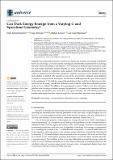Por favor, use este identificador para citar o enlazar a este item:
http://hdl.handle.net/10261/291098COMPARTIR / EXPORTAR:
 SHARE SHARE
 CORE
BASE CORE
BASE
|
|
| Visualizar otros formatos: MARC | Dublin Core | RDF | ORE | MODS | METS | DIDL | DATACITE | |

| Campo DC | Valor | Lengua/Idioma |
|---|---|---|
| dc.contributor.author | Hanlmeli, Ekim Taylan | es_ES |
| dc.contributor.author | Tutusaus, Isaac | es_ES |
| dc.contributor.author | Lamine, Brahim | es_ES |
| dc.contributor.author | Blanchard, Alain | es_ES |
| dc.date.accessioned | 2023-02-17T12:58:31Z | - |
| dc.date.available | 2023-02-17T12:58:31Z | - |
| dc.date.issued | 2022 | - |
| dc.identifier.citation | Universe 8(3): 148 (2022) | es_ES |
| dc.identifier.uri | http://hdl.handle.net/10261/291098 | - |
| dc.description | This article belongs to the Special Issue Alternative Gravities and Fundamental Cosmology. | es_ES |
| dc.description.abstract | The accelerated expansion of the universe implies the existence of an energy contribution known as dark energy. Associated with the cosmological constant in the standard model of cosmology, the nature of this dark energy is still unknown. We will discuss an alternative gravity model in which this dark energy contribution emerges naturally, as a result of allowing for a time-dependence on the gravitational constant, G, in Einstein’s field equations. With this modification, Bianchi’s identities require an additional tensor field to be introduced so that the usual conservation equation for matter and radiation is satisfied. The equation of state of this tensor field is obtained using additional constraints, coming from the assumption that this tensor field represents the space-time response to the variation of G. We will also present the predictions of this model for the late-universe data, and show that the energy contribution of this new tensor is able to explain the accelerated expansion of the universe without the addition of a cosmological constant. Unlike many other alternative gravities with varying gravitational strength, the predicted G evolution is also consistent with local observations and therefore this model does not require screening. We will finish by discussing possible other implications this approach might have for cosmology and some future prospects. | es_ES |
| dc.format | application/pdf | es_ES |
| dc.language.iso | eng | es_ES |
| dc.publisher | Multidisciplinary Digital Publishing Institute | es_ES |
| dc.relation.ispartof | Universe | es_ES |
| dc.relation.isversionof | Publisher's version | es_ES |
| dc.relation.isbasedon | The underlying dataset has been published as supplementary material of the article in the publisher platform at DOI 10.3390/universe8030148 | es_ES |
| dc.rights | openAccess | es_ES |
| dc.subject | Dark energy | es_ES |
| dc.subject | Varying constants | es_ES |
| dc.subject | Alternative gravity | es_ES |
| dc.subject | Cosmology | es_ES |
| dc.title | Can dark energy emerge from a varying G and spacetime geometry? | es_ES |
| dc.type | artículo | es_ES |
| dc.identifier.doi | 10.3390/universe8030148 | - |
| dc.description.peerreviewed | Peer reviewed | es_ES |
| dc.relation.publisherversion | https://doi.org/10.3390/universe8030148 | es_ES |
| dc.identifier.e-issn | 2218-1997 | - |
| dc.rights.license | https://creativecommons.org/licenses/by/4.0/ | es_ES |
| dc.relation.csic | Sí | es_ES |
| oprm.item.hasRevision | no ko 0 false | * |
| dc.type.coar | http://purl.org/coar/resource_type/c_6501 | es_ES |
| item.openairetype | artículo | - |
| item.cerifentitytype | Publications | - |
| item.grantfulltext | open | - |
| item.fulltext | With Fulltext | - |
| item.openairecristype | http://purl.org/coar/resource_type/c_18cf | - |
| item.languageiso639-1 | en | - |
| Aparece en las colecciones: | (ICE) Artículos | |
Ficheros en este ítem:
| Fichero | Descripción | Tamaño | Formato | |
|---|---|---|---|---|
| candark.pdf | 281,06 kB | Adobe PDF |  Visualizar/Abrir |
CORE Recommender
SCOPUSTM
Citations
2
checked on 12-may-2024
WEB OF SCIENCETM
Citations
1
checked on 16-feb-2024
Page view(s)
21
checked on 20-may-2024
Download(s)
69
checked on 20-may-2024
Google ScholarTM
Check
Altmetric
Altmetric
Este item está licenciado bajo una Licencia Creative Commons

